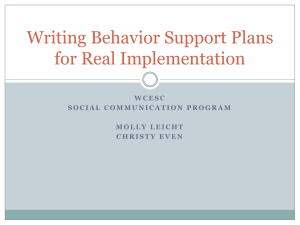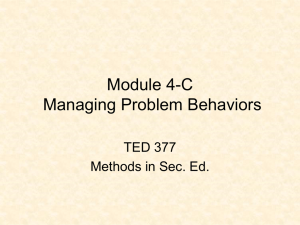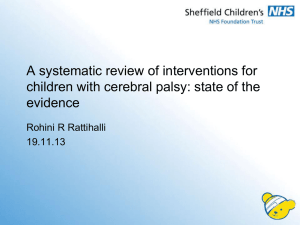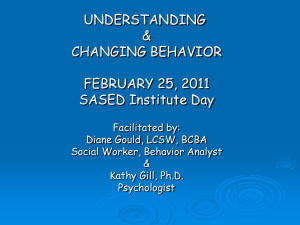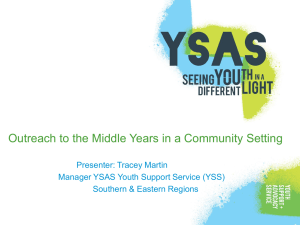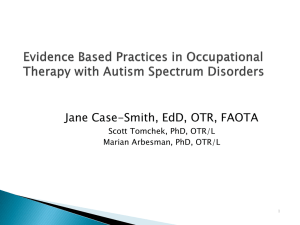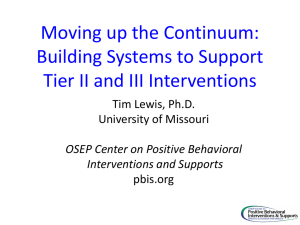Taking on the Tough Ones
advertisement
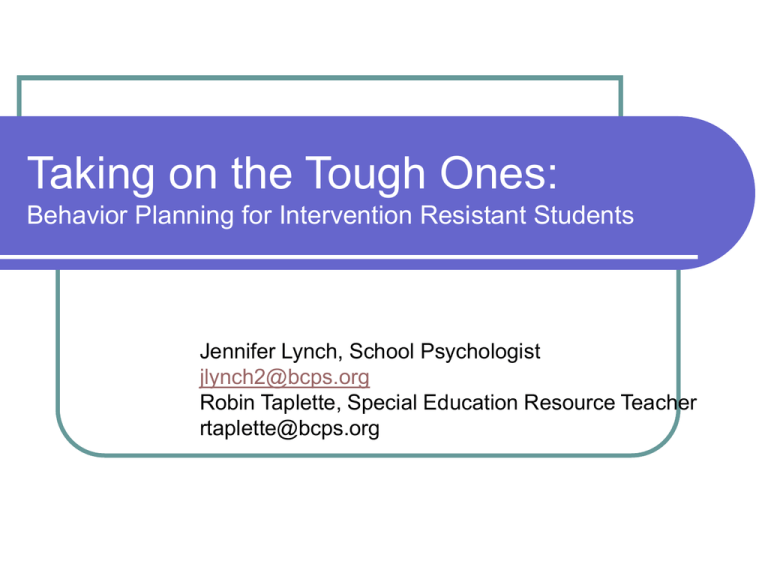
Taking on the Tough Ones: Behavior Planning for Intervention Resistant Students Jennifer Lynch, School Psychologist jlynch2@bcps.org Robin Taplette, Special Education Resource Teacher rtaplette@bcps.org Objectives To understand and apply Behavior Planning using an analytical and systematic approach To learn how to design and implement innovative behavior interventions strategies Red Zone Behavior Planning FBA/BIP implemented and revised multiple times BLS programming and support 1-5% IEP goals to address skill development IEP supplemental services/supports to support behavior needs 5-15% 80-90% Three Main Reasons Behavior Plans Fail Poor, incomplete, or incorrect implementation of interventions Poor alignment with triggers, functions, teacher beliefs/classroom structure, and/or student interest Strong focus on consequences and limited/no focus on skill development Implementation Are the interventions being implemented? BE HONEST! If not, are the interventions Too difficult or complex Too time consuming Poorly aligned with the classroom structure Poorly aligned with teacher beliefs Not appropriate for the student What is working/not working? Can some aspects be changed or tweaked to make the intervention more successful? Are the reinforcers reinforcing to the student and being offered at a rate necessary to change behavior? Group Discussion Discuss why you may have not implemented interventions in the past. How could the interventions have been changed to make implementation easier. Alignment with Triggers A trigger is the event that starts the chain of unwanted behaviors. Questions to ask the team when struggling to identify triggers: If Dr. Hairston was entering the building and your principal told you to make sure the behavior didn’t occur, what would you do to make sure the student didn’t engage in the behavior? If I came into the building and only had 20 minutes to see the student’s behavior, what would you do to make sure I saw the behavior? Look for ways to eliminate the triggers, make them less of a trigger, or help the student manage the trigger Functions in simple terms Behaviors are a way that we communicate what we want when words aren’t working for us The first question to always ask is, “What is this student trying to tell us that we keep missing?” Why a student engages in the behavior is much more important than what they are doing. The “what” may change, but will continue to be a problem until we manage the “why” Most common functions To gain attention To gain control To get a tangible item To get sensory stimulation To avoid work To avoid attention To avoid an activity Attempt to communicate needs Alignment with Functions To Gain Attention To Gain Control Provide choices between work, places to complete work, reinforcers, when to receive help, etc To Gain a Tangible Provide attention for positive behaviors, ignore inappropriate behaviors Provide reinforcement that includes individualized teacher time or peer attention Use a First-Then system of completing a certain task and then having access to tangible Sensory Stimulation Provide sensory aides, such as squeeze balls, bands, standing desks, etc Allow for scheduled times for sensory activities Set timers to allow perseveration for discrete times Alignment with Functions To Avoid Work Create a Work/Break system Provide a break pass Graduate difficulty of work to build success To Avoid Attention Address the student outside of the classroom Provide nonverbal signal that student needs help or wants to participate To Avoid Activity Provide scheduled opportunities to escape Chunk or modify activity Provide activity buddies Offer activity alternative Attempt to Communicate Needs Provide appropriate communication devices Develop social stories/scripts Use picture schedules/cues/nonverbal gestures/etc Develop a “Mad Plan”, an outline of how students will appropriately respond when angry Contact with support specialists to address communication deficits and develop strategies Group Discussion What behaviors baffle you? Let’s discuss a few difficult behaviors and the possible triggers and functions. Alignment with Teacher Beliefs/Classroom Structures Use as much of existing structure and reinforcement systems (school, cluster program, classroom) as possible. Align with the teacher’s discipline and reward philosophies. Train and get input from any staff implementing interventions. ASK the teacher/staff before creating interventions. Help the teacher with implementation the first week to provide feedback and make appropriate changes. Communicate with team one week after implementation to discuss any glitches. If you are the teacher, speak up and be honest before interventions are created. If something isn’t working, let the team know immediately. If you haven’t tried the intervention, ask yourself, “Why about this is making me resistant?” Align with Student Interests Use an interest inventory Interview the student, teacher, coach, parent, etc. Create a point sheet that is of high interest Incorporate choices of reinforcers and rotate frequently Billy didn’t respond to the BLS point sheet, but he LOVES Club Penguin… Johnny loves to read, and hates to write….so we got creative Percent of Total Possible Points earned in Reading 100% 100% 87.50% 80% 60% 41% Classwork 40% Homework 20% Fluency 0% 0% 0% 0% Prior to Implementation After Implementation (4/29/10) But 3 minutes and 3 tasks isn’t reasonable…. Johnny worked for an average of 23 minutes before taking a break Minutes Number of Minutes Worked before Taking a Break 70 60 50 40 30 20 10 0 1 2 3 4 5 6 7 8 9 10 11 12 13 14 15 16 17 18 19 20 21 22 23 Task He completed an average of 4.5 tasks before asking for a break Food for Thought What is your favorite kind of snack? How often do you like to eat it? If you had 15 minutes at work, what would you do? What could your boss do to let you know that he/she appreciated your hard work? If you didn’t know if you were going to get paid at the end of the week, would you still work so hard? How do you feel when someone tells you that teachers don’t deserve raises because they already have an easy job and they get the summers off? Group Discussion Think about the last questions and apply them to your students. What questions could you be asking your students and your staff that would uncover what is motivating for the student? How can we be looking at reinforcers differently? How can we be looking at our students differently? What are the barriers in your school/program to using different reinforcement systems? Is there a way to help your school be more open to new ideas? Replacement Behaviors Effective plans don’t create sterile environments. Effective plans teach the student better strategies to manage real life situations and provide teachers with the tools to help students develop those skills. Plans that only focus on consequences or environmental changes may change the initial behavior of concern, but new behaviors are likely to show up. TEACH new skills and you will be much more successful than trying to stop or punish what you don’t want to see. Skill Development Create skill development interventions that address the student’s specific needs based on the following questions: Does the student know the expectations? Is the student aware of his/her behavior? Is the student able to control the behavior? Can the student perform the expected behavior? Can the student be taught to engage in an appropriate behavior that will make it difficult to continue the problem behavior? Group Discussion What behaviors are the toughest to manage in your building? What skill development do you think would be helpful? What are some creative ways to teach these skills and overcome typical barriers? What have we missed? Are we sure we have the functions and triggers correct? Are we sure we are addressing them correctly? Are we sure that we have tapped into a reinforcement system that is meaningful for the student? Are we sure we understand what behavior we are targeting? Are we thinking outside of the box and individualizing plans? Does the plan only include interventions not being offered to all other students in the program? Have we talked to everyone that works with the student? Are we on the same page? Have we streamlined our interventions to focus on a few good strategies? Are our own ideas, thinking patterns, feelings getting in the way? Take Aways Get creative Less is more Implement! Be a detective Work as a team Behaviors are communication tools Walk a mile in the student’s shoes Questions?



